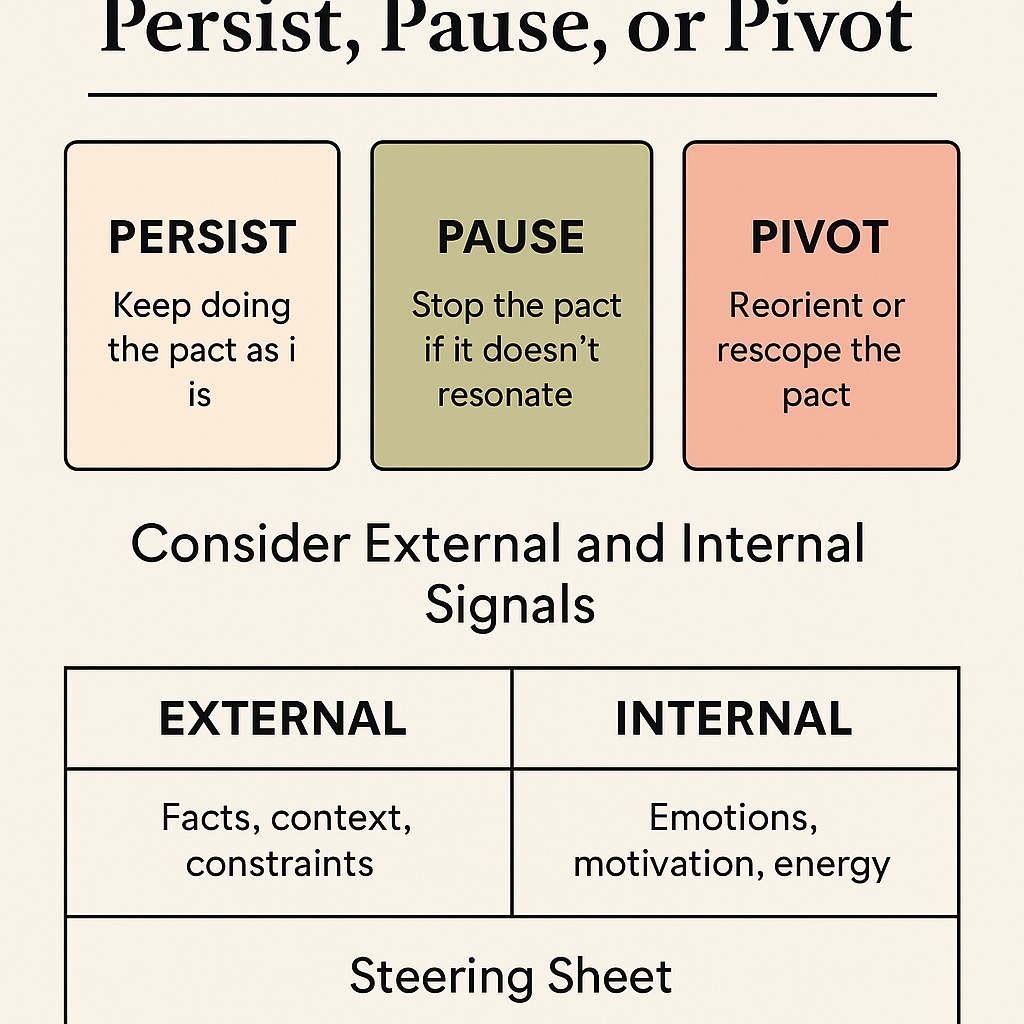Tiny Experiments, REACT: Deciding What’s Next: Persist, Pause, or Pivot - Part 6
After we’ve committed to a PACT, tried it out, and gathered insights through mindful reflection (like the Plus, Minus, Next loop), we eventually reach a fork in the road:
What should I do next with this experiment?
In Chapter 8 of Tiny Experiments, Anne-Laure Le Cunff helps us explore three powerful options: persist, pause, or pivot.
This isn’t just about performance or productivity, it’s about self-alignment, making sustainable choices that honor both our inner world and external reality.
Option 1: Persist , Keep Showing Up
Sometimes, the best move is no move at all. We simply continue with our pact as it is.
It can be tempting to do more, to optimize, expand, or “level up.” But more isn’t always better. Instead of chasing constant growth, the book encourages us to aim for sustainable excellence.
Consistency over intensity. Depth over expansion.
Persisting gives space for:
- Rest and reflection
- Compound interest from small repeated efforts
- Long-term momentum that builds quietly but powerfully
Showing up steadily for something meaningful over time is one of the most underrated superpowers. In a culture obsessed with scaling fast, persisting is often the wisest rebellion.
Option 2: Pause , Let Go (For Now)
There’s courage in choosing to pause a pact.
When something doesn’t resonate anymore, whether emotionally, energetically, or contextually, it’s okay to stop. Not everything needs to be finished. Not every pact needs to be forever.
Le Cunff reminds us to check both internal and external signals:
- Internally: Does this still feel right? Do I feel joy, or just pressure?
- Externally: Are circumstances supporting or draining this pact?
And most importantly:
Pausing is not quitting. It’s an intentional shift to preserve energy and mental health.
We avoid the trap of the sunk cost fallacy, the false belief that we must keep going just because we’ve started. Sometimes the most fulfilling move is to invest that energy elsewhere, and maybe even come back later with fresh eyes.
Option 3: Pivot , Tweak, Reorient, Rescope
Not all experiments fail or succeed cleanly. Many just… evolve.
That’s where pivoting comes in. A pact might still have value, but it needs adjusting to match who we are now.
We might:
- Narrow the scope
- Shift the frequency
- Change the context
- Add a playful twist to rekindle interest
The question becomes:
What part of this pact can change so I can keep learning and growing through it?
Pivoting lets us stay connected to the original intention, while adapting to life’s inevitable changes. Our pacts, like us, are allowed to evolve.
A Better Decision Tool: The Steering Sheet
Most decision-making tools, like pros and cons lists, seem rational, but often just reinforce our existing biases. They tell us what we already want to hear.
Instead, Tiny Experiments offers a more nuanced tool: the Steering Sheet, built around systemic curiosity.
It helps us map both external and internal signals:
| Domain | What to Explore |
|---|---|
| External | Facts, context, constraints, timing |
| Internal | Emotions, motivation, energy, intuition |
Ask yourself:
- How does this pact function in my current situation?
- How does this pact feel in my body and mind?
By giving weight to both dimensions, we build clarity, not just about the pact, but about ourselves.
And importantly, we free ourselves from black-and-white thinking.
There is no wrong choice, just data, movement, and refinement.

The Real Failure Is Mindless Movement
In the end, what matters isn’t whether you persist, pause, or pivot. What matters is that the decision is mindful.
The only real failure? Confusing motion for progress. Acting on autopilot instead of intention.
Success, in this world of tiny experiments, is fluid. Progress is personal. As long as you’re learning, adapting, and choosing with awareness, you’re already winning.
Next, Chapter 9: Dancing with Disruption
We’ll explore how to stay grounded and responsive when the unexpected shakes up everything, how to stay in rhythm with life, even when it changes the beat.
Until then, take a moment to reflect:
Is there a pact in your life right now, big or small, that’s ready to be persisted with, paused for now, or gently pivoted?
Keep experimenting. And remember: the process is the path.